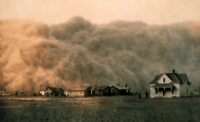
Photo from wikipedia
Dust is regarded as an important pathway of heavy metal(loid)s to the human body. Health risks posed by metal(loid)s from household dust are of particular concern. However, the contamination and… Click to show full abstract
Dust is regarded as an important pathway of heavy metal(loid)s to the human body. Health risks posed by metal(loid)s from household dust are of particular concern. However, the contamination and sources of heavy metal(loid)s in household dust environments, as well as source identification of health risks related to heavy metal(loid)s from household dust for vulnerable populations such as children, have not been thoroughly studied in China, particularly for the areas involved with industrial activities such as ore mining. Thus, a cross-sectional study was conducted in a rural area famous for Pb/Zn ore mining, to assess the pollution sources and health risks of heavy metal(loid)s from household indoor and outdoor dust and to identify the contribution of household dust to the health risks for children. The results indicated that household environment was heavily contaminated by metal(loid)s, which were mainly attributed to mining activity. Meanwhile, the indoor/outdoor ratio and the redundancy analysis indicated that there were other pollution sources in indoor environments such as coal combustion, materials for interior building and decoration. Vapor inhalation was the main exposure pathway for Hg, while ingestion was the predominant pathway for other metal(loid)s. Although the cancer risks were relatively low, the HIt from household indoor and outdoor dust (2.19) was about twice the acceptable limit (1) and was primarily from Pb (64.52%) and As (23.42%). Outdoor dust was a larger contributor to the HI of Sb, As, Cr, Cd, Zn and Pb, which accounted for 51.37%, 58.63%, 52.14%, 59.66%, 52.87% and 64.47%, respectively, and the HIt was mainly from outdoor dust (60.76%). These results indicated that non-cancer health risks were largely from outdoor dust exposure, and strengthened the notion that concern should be given to the potential health risks from metal(loid)s in household dust both originating from mining activity and indoor environmental sources.
Journal Title: Environmental pollution
Year Published: 2021
Link to full text (if available)
Share on Social Media: Sign Up to like & get
recommendations!